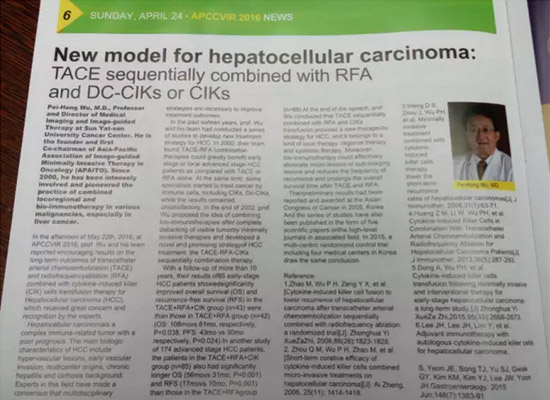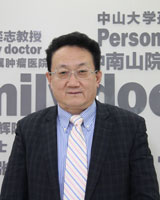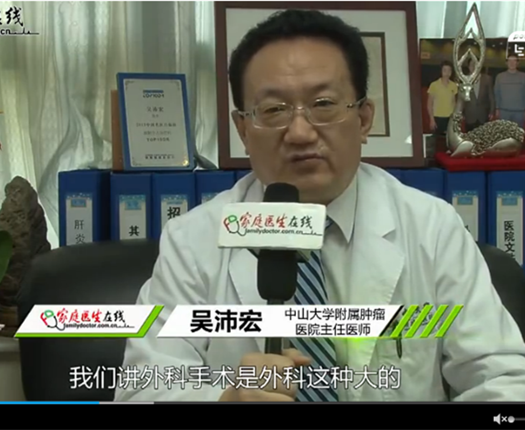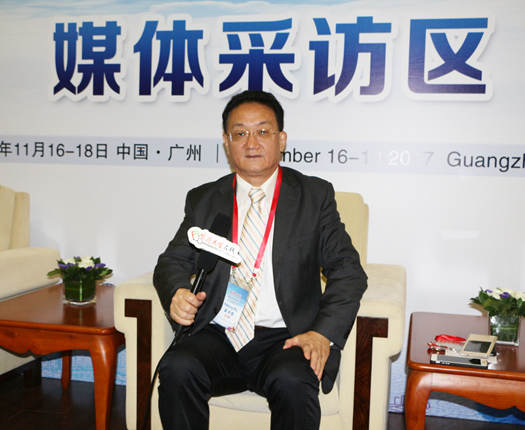【APCCVIR 2016】中山大学肿瘤防治中心吴沛宏教授就肝癌微创联合免疫治疗的研究成果登上大会快讯
本文转载于:环球抗癌之家 微信公众号

封面图片:登上APCCVIR 2016大会快讯
2016年4月22日,在苏州召开的第十二届亚洲心血管介入放射学大会(APCCVIR 2016)上,中山大学肿瘤防治中心吴沛宏教授及其团队公布了中山大学肿瘤防治中心肝癌微创介入联合细胞因子诱导杀伤细胞(DC-CIK)治疗10年随访结果,引起了在场专家热议和认可,并登上了大会快讯头条。这项成果也昭示着我国肝癌的微创介入治疗及综合治疗的水平走在世界前列(图1)。

图1 吴沛宏教授在大会现场接过讲课证书
英文原文如下:
New model for hepatocellularcarcinoma: TACEsequentially combined with RFA and DC-CIKs or CIKs
Pei-Hong Wu, M.D。, Professor and Director of Medical Imaging and Image-guided Therapy at Sun Yat-sen University CancerCenter。 He isthe founder and first Co-chairman of Asia-Pacific Association of Image-guided Minimally Invasive Therapy in Oncology (APAITO)。 Since 2000, he has been intensely involved and pioneered the practice of combined locoregional and bio-immunotherapy in various malignancies, especially in liver cancer。
In the afternoon of May 22th, 2016, at APCCVIR 2016, prof.Wu and his team reported encouraging resultson the long-term outcomes of transcatheterarterial chemoembolization (TACE) and radiofrequencyablation(RFA)combined with cytokine-induced killer (CIK) cells transfusion therapy forHepatocellularcarcinoma (HCC), which received great concern and recognition bythe experts。
Hepatocellular carcinomais a complex immune-relatedtumorwith apoor prognosis。 The main biologic characteristics of HCCincludehypervascular lesions, early vascular invasion, multicenter origins,chronichepatitis and cirrhosis background。 Experts in this field have made a consensus that multidisciplinary strategies are necessary to improve treatment outcomes。
In the past sixteen years, prof。 Wu and his team had conducted a series of studies to develop new treatment strategy for HCC。 In2000, their team found TACE-RFA combinationtherapies could greatly benefit early stage or local advanced stage HCCpatients as compared with TACE or RFAalone。 At the same time, some specialists started to treat cancer by immunecells, including CIKs, Dc-CIKs, while theresults remained unsatisfactory。 Inthe end of 2002, prof。 Wu proposed the ideaof combining bio-immunotherapies after complete debarking of visible tumor byminimally invasive therapies and developed a novel and promising strategy ofHCC treatment: the TACE-RFA-CIKs sequentially combination therapy。
With a follow-up of more than 10 years, their results of 85 early-stage HCC patients showed significantly improved overall survival (OS)and recurrence-free survival (RFS) in theTACE+RFA+CIK group (n=43) were thanthose in TACE+RFA group (n=42) (OS: 108 movs 61 mo, respectively, P=0.038;PFS:43mo vs 30mo respectively, P=0.024)。 In another study of 174 advanced stage HCC patients, the patients in the TACE+RFA+CIK group (n=85) also had significantly longer OS (56 mo vs 31 mo, P=0.001)and RFS (17 mo vs 10mo, P=0.001)than those in the TACE+RFAgroup (n=89)。 At the end of thespeech,prof。 Wu concluded that TACE sequentially combined with RFA and CIKs transfusion provides a new therapeutic strategy for HCC, and it belongs toakind of local therapy, regional therapy and systemic therapy。 Moreover,bio-immunotherapycould effectively eliminate micro-lesions or sub-imaging lesions and reduces the frequency of recurrence and prolongs the overall survival time after TACEand RFA。
Their preliminary results had been reported and awardedat the AsianCongress of Cancer in 2005, Korea。 And the series of studies havealso beenpublished in the form of five scientific papers on the high-level journals in associated field。 In 2015, a multi-centric randomized control trial including four medical centers in Korea draw the same conclusion。
Reference:
1.Zhao M, WuP H, Zeng Y X, et al。 [Cytokine-inducedkiller cell fusion to lower recurrenceof hepatocellular carcinoma aftertranscatheter arterial chemoembolizationsequentially combined withradiofrequency ablation: a randomized trial][J].Zhonghua Yi Xue Za Zhi,2006,86(26):1823-1828。
2。 Zhou Q M, Wu P H, Zhao M, et al。 [Short-termcurativeefficacy of cytokine-induced killer cells combined micro-invasivetreatments onhepatocellular carcinoma][J]。 Ai Zheng, 2006,25(11):1414-1418。
3.Weng D S, Zhou J, Wu PH, et al。 Minimally invasivetreatmentcombined with cytokine-induced killer cells therapy lower theshort-term recurrence rates ofhepatocellular carcinomas[J]。 J Immunother,2008,31(1):63-71。
4.Huang Z M, Li W, Wu PH, et al。 Cytokine-induced KillerCellsin Combination With Transcatheter Arterial Chemoembolization andRadiofrequencyAblation for Hepatocellular Carcinoma Patients[J]。 J Immunother,2013,36(5):287-293。
5.Dong A, Wu PH, et al。 Cytokine-induced killercellstransfusion following minimally invasive and interventional therapyforearly-stage hepatocellular carcinoma:along-term study。[J] Zhonghua Yi Xue Za Zhi,2015,95(33):2668-2673。
6.Lee JH, Lee JH, Lim Y, et al。 Adjuvantimmunotherapywith autologous cytokine-induced killer cells for hepatocellularcarcinoma。
S, Yeon JE, Song TJ, Yu SJ, Gwak GY, Kim KM, Kim YJ, LeeJW,Yoon JH。 Gastroenterology。 2015Jun;148(7):1383-91
- 《柳叶刀》主刊发表中山大学肿瘤防治中心张力教授
鼻咽癌是东南亚及华南非常常见的恶性肿瘤。对于早期和局部晚期的鼻咽癌患者... 详情>
- 2016年ASCO:中山大学肿瘤防治中心张力教
2016年6月3日——7日,第52届美国临床肿瘤学会年会(ASCO)在... 详情>
- 中山大学肿瘤防治中心食管癌研究团队集体亮相世界
(中山大学肿瘤防治中心报道)第十三届世界食管疾病大会于2015年8月3... 详情>
- 广东省癌症中心落户中山大学肿瘤防治中心
癌症是一类复杂的常见病、多发病。全球每年因癌症死亡的人数约为820万,... 详情>
- 乳腺纤维瘤微创手术
- 乳腺纤维瘤手术
- 嗜铬细胞瘤
- 基底细胞瘤
- 脂肪肉瘤
- 滑膜肉瘤
- 子宫肉瘤
- 子宫内膜间质肉瘤
- 肺癌晚期症状
- 肺癌的治疗方法
- 肺癌化疗
- 肺癌化疗方案
- 肺癌有什么症状
- 肺癌转移
- 肺癌药物
- 乳腺肿块
- 介入科
- 介入疗法
- 腔道介入
- 宫颈囊肿
- 这几个止癌痛的方法不错
癌症患者除了癌症本身对于患者身体的摧残以外,癌症带来的痛苦也让患者如置...详情>
- 直肠癌晚期会转移到哪些部位?
直肠癌相对于其他部位的癌症来说,其对应的治疗难度是较低的,毕竟直肠是可...详情>
- 睾丸癌的诱因和治疗方法
男性睾丸癌是什么原因造成的呢?男性生殖疾病如果没有重视治疗,久而久之就...详情>
- 什么年龄段易患胃癌?
我国是胃癌大国,近年来发病人数也呈增长趋势,也越来越年轻化,我们可以从...详情>
- 肿瘤治疗后要如何护理?
在生活方式和环境不断改变的同时,我们身边患上肿瘤的患者开始变得越来越多...详情>



